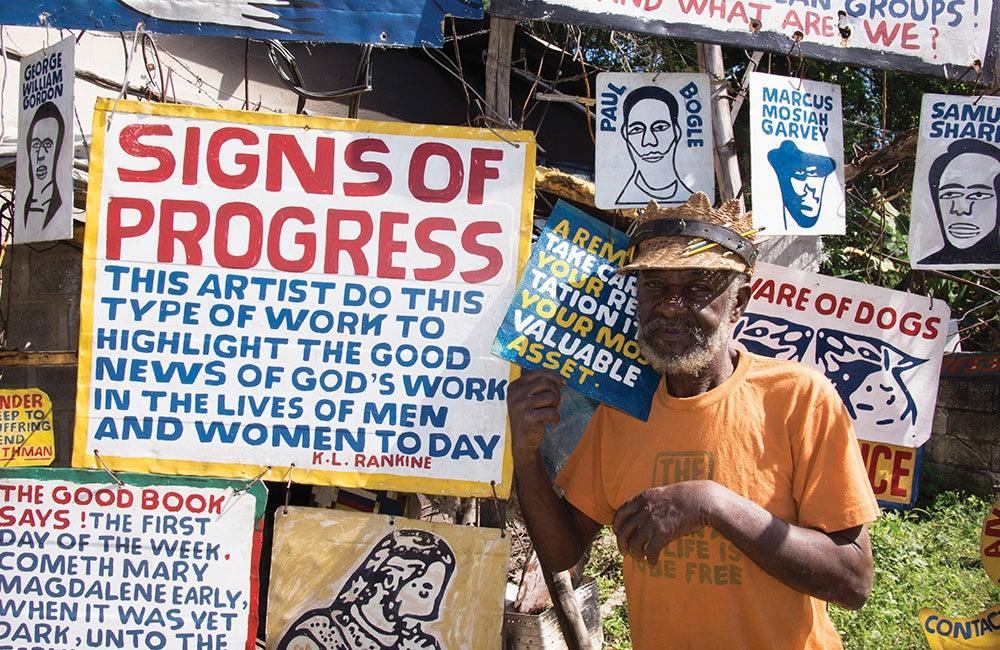First published: Summer 2018
Jamaica has a well-earned reputation for its self-taught, popular artists, with major names such as John Dunkley, Mallica “Kapo” Reynolds, and Everald Brown. These artists have been championed by influential figures in the artistic community, such as the late David Boxer, who was Chief Curator at the National Gallery of Jamaica and in 1979 coined the term “Intuitive” to describe such artists. I have argued elsewhere that the resulting Intuitives’ canon, while it provided recognition to artists of undeniable importance, was too purist in what were externally imposed definitions and also disregarded the enormous cultural changes that have occurred in the last decades. There must have been many self-taught artists who never made it into the collections, exhibitions and publications that shaped this field, because their work did not meet the prevailing definitions of “art” or “Intuitive art”.
There is a sense now that the golden age of the Intuitives is over in Jamaica, with no major new names appearing for many years. The case of the painter Kemel Rankine, who has been active since the 1990s, is interesting in this regard. Rankine was first brought to my attention about three years ago by Robin Farquharson, a Jamaican photographer who lives in Negril, and, more recently, by Jacqueline Bishop, a New York City-based Jamaican writer and artist who has taken Rankine’s work to the 2017 Santa Fe Folk Art Market and the 2018 Outsider Art Fair in New York City. His ascent to fame has been rapid, but we must ask why it took so long for that to happen.

photo: Veerle Poupeye
The reason appears to be that Rankine is first and foremost a sign painter. Many of Jamaica’s well-known self-taught artists have been involved in sign-painting at some point in their lives, but that is usually regarded as peripheral to their “real” artistic work and not given the same status. I was initially drawn to Rankine’s figurative paintings, particularly his River Mummas. The River Mumma is a sacred and feared mermaid from Jamaican folklore, and she is the mother of freshwater fish. Images of her are a closer match to what is typically expected from self-taught artists in Jamaica, but it is his text-based and graphic signs that really captured my interest, as these are central to his aesthetic and personal philosophy, and to understanding his figurative work.
Kemel Leeford Rankine, as his full name goes, was born in 1944 in the district of Maybole, in the largely rural parish of St Elizabeth in the southwest of Jamaica. He started sign-painting in 1990, after an injury to his leg which made it difficult for him to do more physically demanding work. He now operates a roadside stall at the western end of Bamboo Avenue, a landmark road and tourist attraction in St Elizabeth which is shaded by giant bamboo, with a beautiful, cathedral-like effect.
Rankine’s stall is located at a “jerk pit” – where Jamaica’s famous jerked chicken is prepared and sold – and he occupies a small workshop to the side of the restaurant. In front of his workshop, he displays an array of painted signs and figurative paintings, suspended from a helter-skelter system of poles and wires to form a colourful, patchwork screen in front of his work area – a literal forest of signs.

He works in enamel on reclaimed metal, which mainly comes from large appliances such as old refrigerators, and his work represents a fertile tradition of “upcycling” discarded materials in Jamaica’s popular culture. He attracts tourists and other casual buyers, but he has developed relationships with several regular patrons who bring him metal to work on and occasionally give him small commissions or make suggestions, to which he is receptive. It was one such patron who encouraged him to start painting River Mummas, which are now a staple of his production.
This is an article extract; read the full article in Raw Vision #98




